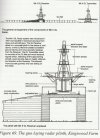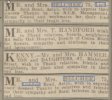Maybe they are simply hop wires?A further thought.
Could this group have been photographed on the edge of a heavy anti-aircraft battery? In which case they could have been the team which manned it. But, again, where?
Chris
-
Welcome to this forum . We are a worldwide group with a common interest in Birmingham and its history. While here, please follow a few simple rules. We ask that you respect other members, thank those who have helped you and please keep your contributions on-topic with the thread.
We do hope you enjoy your visit. BHF Admin Team -
HI folks the server that hosts the site completely died including the Hdd's and backups.
Luckily i create an offsite backup once a week! this has now been restored so we have lost a few days posts.
im still fixing things at the moment so bear with me and im still working on all images 90% are fine the others im working on now
we are now using a backup solution
You are using an out of date browser. It may not display this or other websites correctly.
You should upgrade or use an alternative browser.
You should upgrade or use an alternative browser.
Home Guard
- Thread starter rocketron
- Start date
oldMohawk
gone but not forgotten
I've looked at images on BFA which correspond to the map and there are open spaces which match the map but none seem to match the view in the photo. Looking at the tall mature trees behind the gun suggests to me a more rural area. There seem to be buildings in the distance as shown on the image below. The unusal suggested radio aerial seems to be covered by a net and is maybe not an aerial.


paul stacey
master brummie
I think they are allotments, and maybe on the edge of an urban area, as by this time all spare land was laid to cultivation, looks like beans of soft fruit frames. Paul
maypolebaz
master brummie
The gun is a Bofors, Chris.(Light Ack Ack).A further thought.
Could this group have been photographed on the edge of a heavy anti-aircraft battery? In which case they could have been the team which manned it. But, again, where?
Chris
I like mikegee's idea of a radar installation.
Thanks for all the thoughts. Useful indeed! The background COULD of course be anything at all, including horticultural, but I am now firmly of the conclusion that Mike has it right - MkII Ground Laying Radar.
It appears that many AA batteries had this ground laying radar set-up. It had been established that the best way to get accurate readings of aircraft direction and altitude was to ensure that the area surrounding the detection equipment was flat. To achieve that, huge (130 yard diameter) octagonal ground mats were created covering an area of about 15,000 square yards; these were 2" mesh (chicken wire), they consumed 230 rolls of material (each 4' x 50 yards) and 650 miles of wire and they were elevated some feet from the ground by means of poles. They took a team of 50 men about four weeks to construct. There was transmitting equipment on the edge of the mat and a receiver stuck right in the middle of it. You can just see one of the latter in the middle of the photograph background.
There were hundreds of these at anti-aircraft batteries around the country. The technology was superseded before the end of the war but existing set-ups were kept in operation. Whilst the move of some Home Guards in 1942/43 from normal infantry duties to the manning of AA batteries was usually to the newer "Z" rocket batteries, many men also manned more conventional batteries, including both heavy and light guns. I am pretty sure that this is one of them, operated at least in part by members of the 24th Warwickshire Home Guard.
The question remains, where? A Home Guard is unlikely to have had a battery on his doorstep but is certain to have been directed to one located not too far away. The men worked on a shift pattern, with a large number of men on the roll, and they would have been regularly moved to and from the battery by lorry from assembly points near to their home.
Looking at where AA sites were in Birmingham, three or four (commutable) possibilities come to mind: Swanshurst Park, Yardley Wood; Oaklands and Glebe Farm, both Yardley area; and just possibly Olton Hall. Would all of these have accommodated mature trees in the background at that time?
No opinion on sunglasses, except - has to be unlikely and much more probably the quirk of a not very good print!
Thanks again for the ongoing interest.
Chris
(Sources: Wikipedia, Royal Artillery website etc.)
It appears that many AA batteries had this ground laying radar set-up. It had been established that the best way to get accurate readings of aircraft direction and altitude was to ensure that the area surrounding the detection equipment was flat. To achieve that, huge (130 yard diameter) octagonal ground mats were created covering an area of about 15,000 square yards; these were 2" mesh (chicken wire), they consumed 230 rolls of material (each 4' x 50 yards) and 650 miles of wire and they were elevated some feet from the ground by means of poles. They took a team of 50 men about four weeks to construct. There was transmitting equipment on the edge of the mat and a receiver stuck right in the middle of it. You can just see one of the latter in the middle of the photograph background.
There were hundreds of these at anti-aircraft batteries around the country. The technology was superseded before the end of the war but existing set-ups were kept in operation. Whilst the move of some Home Guards in 1942/43 from normal infantry duties to the manning of AA batteries was usually to the newer "Z" rocket batteries, many men also manned more conventional batteries, including both heavy and light guns. I am pretty sure that this is one of them, operated at least in part by members of the 24th Warwickshire Home Guard.
The question remains, where? A Home Guard is unlikely to have had a battery on his doorstep but is certain to have been directed to one located not too far away. The men worked on a shift pattern, with a large number of men on the roll, and they would have been regularly moved to and from the battery by lorry from assembly points near to their home.
Looking at where AA sites were in Birmingham, three or four (commutable) possibilities come to mind: Swanshurst Park, Yardley Wood; Oaklands and Glebe Farm, both Yardley area; and just possibly Olton Hall. Would all of these have accommodated mature trees in the background at that time?
No opinion on sunglasses, except - has to be unlikely and much more probably the quirk of a not very good print!
Thanks again for the ongoing interest.
Chris
(Sources: Wikipedia, Royal Artillery website etc.)
(Discussion on Robert Bernard Silk, 30th Warwickshire (Birmingham) Battalion, now in a dedicated thread, here).
Back to that group photograph of a Home Guard unit on an anti-aircraft battery site (and thanks again for the help given by members here).
A member of the unit was George Belcher (below), an apprentice toolmaker who lived in Hillfield Road, Sparkhill. I have some information about that young man from his family and elsewhere and have published it on a website page, here: http://www.staffshomeguard.co.uk/DotherReminiscences177A24thWarks.htm (It's safe to click on).
This information includes high definition images of dozens of George's comrades, from Moseley and adjacent areas, and these are of sufficient quality to identify some of the local men who served.
Chris
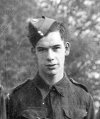
A member of the unit was George Belcher (below), an apprentice toolmaker who lived in Hillfield Road, Sparkhill. I have some information about that young man from his family and elsewhere and have published it on a website page, here: http://www.staffshomeguard.co.uk/DotherReminiscences177A24thWarks.htm (It's safe to click on).
This information includes high definition images of dozens of George's comrades, from Moseley and adjacent areas, and these are of sufficient quality to identify some of the local men who served.
Chris

Without asking anyone to spend too much time on this, I'm wondering if any of our wonderful family history experts could tell me whether there is any obvious family connection between this George Belcher (b.1923) who was living in 1939 at 76 Hillfield Road, Sparkhill and Thomas Belcher of 75 Lichfield Road, Aston who received injuries (from which he died on 7 November 1940) whilst on Home Guard duty in the city centre. The record of the latter's death seems to show no immediate family members, such as parents.
Thanks for any information.
Chris
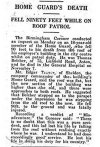
Thanks for any information.
Chris

Thanks for all that. I suppose the final question is, then, the background of George's Dad, Henry/Harry Belcher, married to Rose, died late 1920s. If he was born a Brummie, rather than with a Wigan connection like Alfred, that would be the proof of no link. (Sorry if someone has already looked at this).
Chris
Chris
MWS
from Bham
The George Belcher at Hillfield Road was a George Samuel Belcher born 27th Aug 1924 (d1986 Leicester). He was the son of George Belcher and Hilda Cashmore (m1916). George (father) was possibly born Lichfield and his father was an Albert Belcher who was born in Kings Heath.
Alfred's father was born Oxford 1842ish.
Alfred's father was born Oxford 1842ish.
mw0njm.
A Brummie Dude
has anyone used this site at all please, befor i enter any details
Home Guard Records - Search "Dads Army" Personnel Records ...
Haven't had any experience of it, Pete, but should be very interested to know how useful it is. In particular, how much additional information they have beyond the basic stuff about Home Guard officers which appears in the (published) Home Guard list of February 1941. The latter is restricted to name, initials, 1941 Battalion affiliation and, very occasionally, awards and previous regiment . The suggestion is that they might well be offering more.
It seems to work – I have located my own father although I'm not at the moment in a position to follow up on it.
Could you let us know your experience in due course please? Thanks.
Chris
It seems to work – I have located my own father although I'm not at the moment in a position to follow up on it.
Could you let us know your experience in due course please? Thanks.
Chris
Not quite Birmingham, I'm afraid, but not too far off it - Kenilworth Castle.
I've recently been given one or two quite remarkable photographs of a gathering there, demonstrating the might of a mobile Home Guard unit and, especially, a big gathering of Beaverettes, the nearest thing to an officially sanctioned and supplied armoured car that the Home Guard got. Most probably mainly Coventry blokes but let's hope there are one or two Brummies there to justify its inclusion! I'll post the best picture here but there are a couple of others of interest too.
It would be good to obtain further information about this gathering as our knowledge of it is a bit scanty. Contemporary press coverage, perhaps, although it all might have been too militarily sensitive a subject....
I have put all the information I have online, including magnified images, here: www.staffshomeguard.co.uk/DotherReminiscences181Coventry.htm It's safe to click on.
Chris
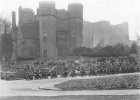
I've recently been given one or two quite remarkable photographs of a gathering there, demonstrating the might of a mobile Home Guard unit and, especially, a big gathering of Beaverettes, the nearest thing to an officially sanctioned and supplied armoured car that the Home Guard got. Most probably mainly Coventry blokes but let's hope there are one or two Brummies there to justify its inclusion! I'll post the best picture here but there are a couple of others of interest too.
It would be good to obtain further information about this gathering as our knowledge of it is a bit scanty. Contemporary press coverage, perhaps, although it all might have been too militarily sensitive a subject....
I have put all the information I have online, including magnified images, here: www.staffshomeguard.co.uk/DotherReminiscences181Coventry.htm It's safe to click on.
Chris

mw0njm.
A Brummie Dude
Yes, sort of, but on nothing like the same scale. They were called the Volunteers. I have a couple of pictures, one of the Sutton unit and the other of the Knowle and Dorridge which includes my grandfather as a serving member and also my father, standing there as a guest whilst on convalescent leave from the Western Front. Both images are online.
Chris
Chris
Full military powers, I think. And undoubtedly needed. This is the first set of orders from Battalion HQ at Aldridge to my father's Little Aston Platoon received at 23.15 on July 5th, 1940:
No thoughts of future litigation/Courts of Enquiry/prosecutions at THAT moment!
Chris
Information.
Reliable reports state that attack on this country is imminent. Attack may take the form of intensive aerial bombardment, landing by paratroops or landings from troop-carrying planes, and attack by sea.
Intention.
(a) Companies will obtain and report definite information of any such attempt.
(b) Companies will pin down, defeat and destroy any enemy who may land, by active attack with every weapon available, whether lethal or improvised. Defence will always be active.
Method.
2(b) does not mean attacks by small patrols and/or posts on large posts of enemy, but by surprise effect of controlled fire from carefully pre-selected positions. The observation posts, patrol posts and barriers, will be defended with vigour and determination.
There must not be and will not be any question of retirement.
No thoughts of future litigation/Courts of Enquiry/prosecutions at THAT moment!
Chris
mw0njm.
A Brummie Dude
thanks ChrisFull military powers, I think. And undoubtedly needed. This is the first set of orders from Battalion HQ at Aldridge to my father's Little Aston Platoon received at 23.15 on July 5th, 1940:
Information.Reliable reports state that attack on this country is imminent. Attack may take the form of intensive aerial bombardment, landing by paratroops or landings from troop-carrying planes, and attack by sea.Intention.(a) Companies will obtain and report definite information of any such attempt.(b) Companies will pin down, defeat and destroy any enemy who may land, by active attack with every weapon available, whether lethal or improvised. Defence will always be active.Method.2(b) does not mean attacks by small patrols and/or posts on large posts of enemy, but by surprise effect of controlled fire from carefully pre-selected positions. The observation posts, patrol posts and barriers, will be defended with vigour and determination.There must not be and will not be any question of retirement.
No thoughts of future litigation/Courts of Enquiry/prosecutions at THAT moment!
Chris
thanks Chris
Attachments
mw0njm.
A Brummie Dude
I'm sorry, I seem to have missed these two posts at the time, Paul.Howard Fisher Morris, my dad's step brother, killed in Victoria Rd Aston during an air raid on the 30th July 1942 when serving with the Home guard.
I should like to put a note commemorating Howard Fisher and his life and sacrifice in the Birmingham section of the staffshomeguard website, if that's OK with you. Before I do so, do you have readily available any further information about him - such as year of birth or age, family, where he lived, what his trade was; and anything at all about his Home Guard service, memories, documentation, the circumstances of his death?
Thanks.
Chris

